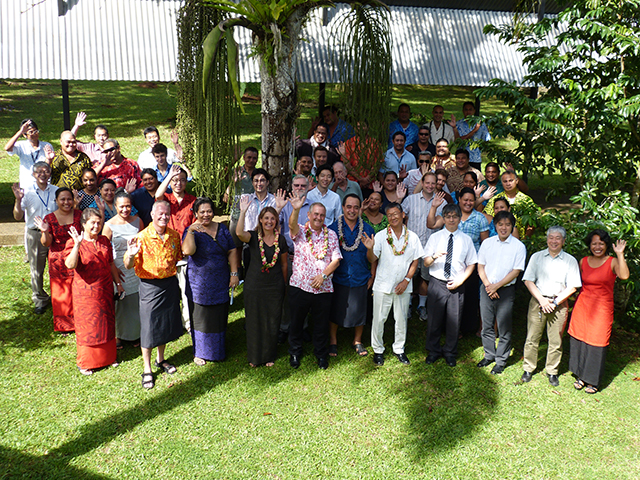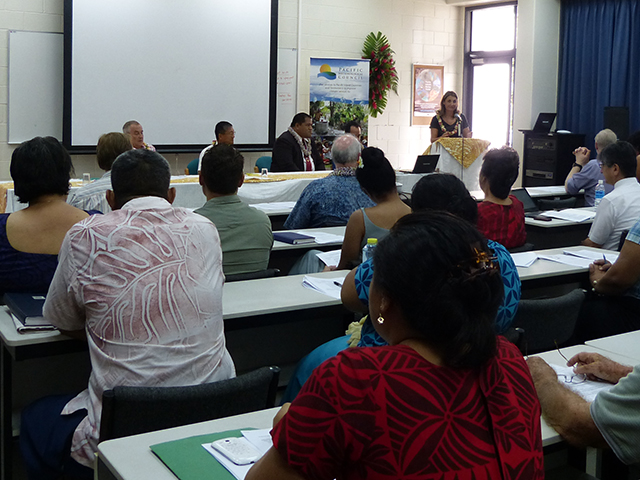
Climate Change Resilience
11 April 2014: Apia Samoa. In February 2011, the Christchurch Earthquake that resulted in the deaths of 185 people and losses estimated at up to NZD 40 billion was followed just 11 days later by the Great East Japan Earthquake and tsunami that brought tremendous losses to the people of Japan. In 2009, an earthquake of magnitude 8.1 resulted in a tsunami that caused the loss of 189 lives in Samoa, American Samoa and Tonga.
Earthquakes and volcanic activity are part of life for people living in the ever-active Pacific "ring of fire", the name given to the geological area where the Earth's techtonic plates meet, causing a great deal of activity beneath the surface of the planet. However the devastation they cause never fails to result in sorrow and hardship.
While we cannot stop a natural disaster from occurring such as a tsunami, we can learn from each one and potentially build our capacity to better predict and therefore react to these natural events.
In 2012, the Prime Minister of Japan, His Excellency Mr Yoshihiko Noda, and New Zealand Prime Minister, John Key, committed to working together to share lessons learned from the 2011 earthquake and tsunami with the aim of progressing"towards a safer Southwest Pacific".
To this end, the fifth Japan-New Zealand Conference on "Lessons learned from the 2011 earthquake and tsunami, and progress towards a safer Southwest Pacific" was held in Apia, Samoa on Friday 11 April. Experts in hazard and risk assessment, seismic and volcanic activity and in disaster risk management from Samoa, Japan and New Zealand participated at this one-day workshop held at the Secretariat of the Pacific Regional Environment Programme (SPREP).

"Japan, Samoa and New Zealand are of course no exceptions of such countries. The tragic disasters the three countries had to go through in the past few years, however, greatly raised our awareness, preparedness, and resilience vis-à-vis natural anomalies of the sort. This is why we are gathering here today so as to share our experiences and lessons learned amongst ourselves and to further take the advantage to bring benefits to other parts of the region," he said.
Suluimalo Amataga Penaia, Chief Executive Officer of the Ministry of Natural Resources and Environment and Chairman of the Disaster Advisory Committee, delivered the Official Opening Address on behalf of the Government of Samoa.
"The Government of Samoa is committed to reducing tsunami risks by implementing well-informed, appropriate and sustainable prevention measures as well as through strengthening an end-to-end early warning system. This can only be achieved through close collaboration with the vulnerable communities and development partners such as Japan, New Zealand, China, SPC/SOPAC and UNESCO IOC's Intergovernmental Coordination Group for the Pacific Tsunami Warning and Mitigation System".

New Zealand High Commissioner, Jackie Frizelle, said "Given all three countries share similar risks and experiences, disaster risk management is an area of mutual interest. We are meeting in Apia because we have a common objective: to share the scientific knowledge and technical expertise developed in Japan and New Zealand with our Pacific neighbours, in order to save lives. From New Zealand's perspective, assisting countries to reduce risks from disasters and to build resilience is one of the four most important priorities of the New Zealand Aid Programme."
SPREP Director General, David Sheppard notes, "While seismic and volcanic hazards are beyond the scope of SPREP's current work, we fully support the work in this area. Through the Pacific Meteorological Desk, SPREP is supporting the capacity building of national meteorological services, which are integral to early warning capacities of national disaster management offices. Capacities built in early warning systems, preparedness and response will also be useful complements to resilience building for other natural disasters and climate change."
"The more resilient our communities are to all forms of natural disasters, the greater our chances of achieving sustainable development".
For further information please contact Espen Ronneberg.
Earthquakes and volcanic activity are part of life for people living in the ever-active Pacific "ring of fire", the name given to the geological area where the Earth's techtonic plates meet, causing a great deal of activity beneath the surface of the planet. However the devastation they cause never fails to result in sorrow and hardship.
While we cannot stop a natural disaster from occurring such as a tsunami, we can learn from each one and potentially build our capacity to better predict and therefore react to these natural events.
In 2012, the Prime Minister of Japan, His Excellency Mr Yoshihiko Noda, and New Zealand Prime Minister, John Key, committed to working together to share lessons learned from the 2011 earthquake and tsunami with the aim of progressing"towards a safer Southwest Pacific".
To this end, the fifth Japan-New Zealand Conference on "Lessons learned from the 2011 earthquake and tsunami, and progress towards a safer Southwest Pacific" was held in Apia, Samoa on Friday 11 April. Experts in hazard and risk assessment, seismic and volcanic activity and in disaster risk management from Samoa, Japan and New Zealand participated at this one-day workshop held at the Secretariat of the Pacific Regional Environment Programme (SPREP).

Ambassador of Japan to Samoa, Mr. Kazumasa Shibuta, said the particular focus on tsunami disaster management adds to the versatility of the meeting and its potential for the future, since the theme corresponds to great interests for Pacific island countries exposed to increasing risk and vulnerability to tsunami disasters.
"Japan, Samoa and New Zealand are of course no exceptions of such countries. The tragic disasters the three countries had to go through in the past few years, however, greatly raised our awareness, preparedness, and resilience vis-à-vis natural anomalies of the sort. This is why we are gathering here today so as to share our experiences and lessons learned amongst ourselves and to further take the advantage to bring benefits to other parts of the region," he said.
Suluimalo Amataga Penaia, Chief Executive Officer of the Ministry of Natural Resources and Environment and Chairman of the Disaster Advisory Committee, delivered the Official Opening Address on behalf of the Government of Samoa.
"The Government of Samoa is committed to reducing tsunami risks by implementing well-informed, appropriate and sustainable prevention measures as well as through strengthening an end-to-end early warning system. This can only be achieved through close collaboration with the vulnerable communities and development partners such as Japan, New Zealand, China, SPC/SOPAC and UNESCO IOC's Intergovernmental Coordination Group for the Pacific Tsunami Warning and Mitigation System".

New Zealand High Commissioner, Jackie Frizelle, said "Given all three countries share similar risks and experiences, disaster risk management is an area of mutual interest. We are meeting in Apia because we have a common objective: to share the scientific knowledge and technical expertise developed in Japan and New Zealand with our Pacific neighbours, in order to save lives. From New Zealand's perspective, assisting countries to reduce risks from disasters and to build resilience is one of the four most important priorities of the New Zealand Aid Programme."
SPREP Director General, David Sheppard notes, "While seismic and volcanic hazards are beyond the scope of SPREP's current work, we fully support the work in this area. Through the Pacific Meteorological Desk, SPREP is supporting the capacity building of national meteorological services, which are integral to early warning capacities of national disaster management offices. Capacities built in early warning systems, preparedness and response will also be useful complements to resilience building for other natural disasters and climate change."
"The more resilient our communities are to all forms of natural disasters, the greater our chances of achieving sustainable development".
For further information please contact Espen Ronneberg.